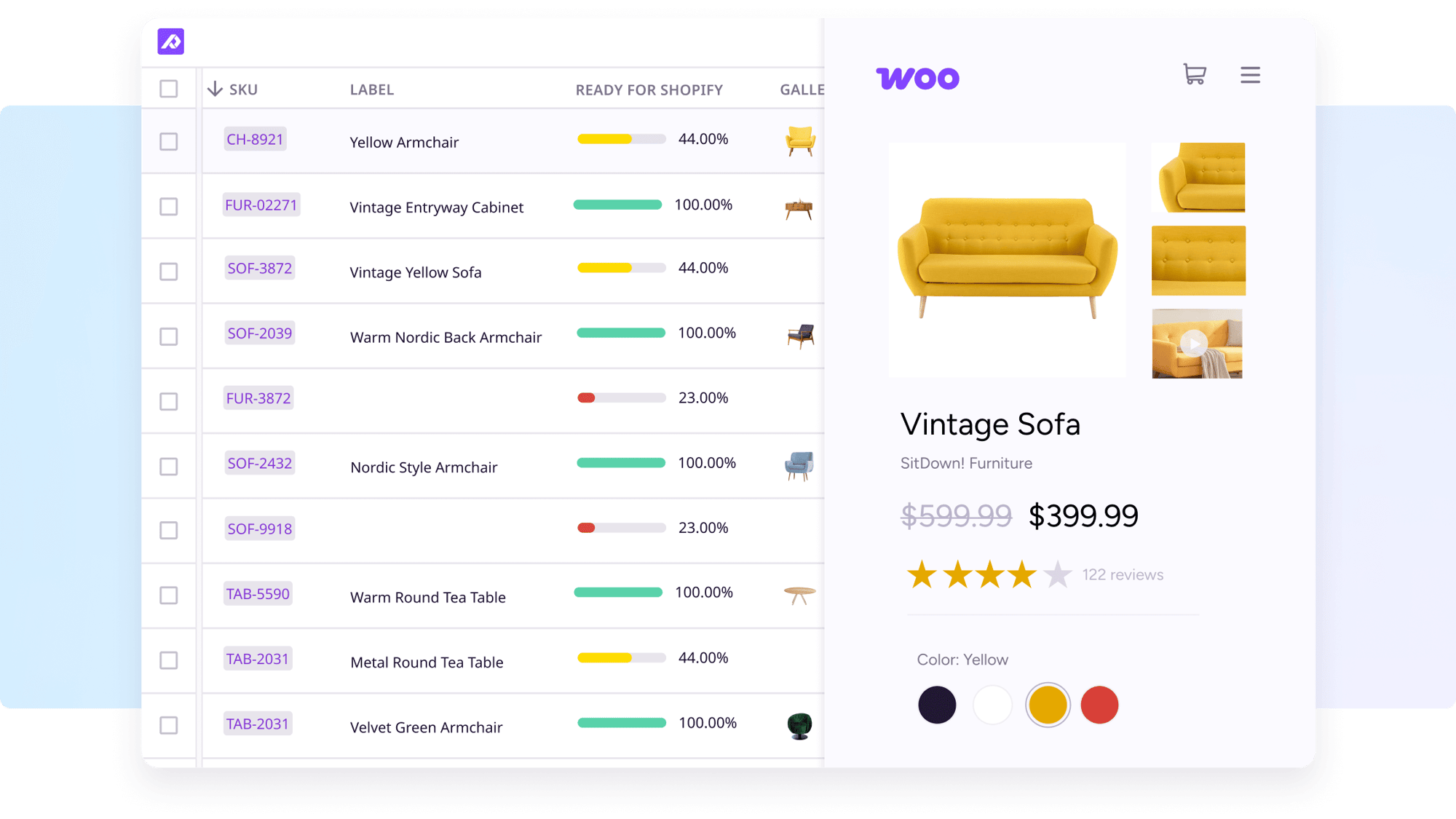PIM for WooCommerce
All your product content.
Ready for WooCommerce.



Ranked Best PIM software in G2's Best Commerce Awards 2025

Work as a team
Managing product data is a team effort. Easily collaborate with your team using specialized views and work together at the same time without stepping on each other's toes.
Be safe, not sorry
With Plytix your team can work on product content in a safe space outside WooCommerce.
This means no more accidental product content errors on your store.
What can Plytix do for you and your WooCommerce store

Keep your WooCommerce store up-to-date with minimal effort
Create and update products insanely fast
No more product errors or data gaps
Schedule automatic product updates with your Plytix feed and a data import plugin (like WP All Import)

Automate mundane tasks
Easily find gaps in your product data
Automate mundane data enrichment tasks
Take back thousands of hours of your life

Step up your content game
Create content that ranks for your sales channels
Create content that makes people want to buy
Create content so good, you’ll brag about it

Automatically rename and resize all your images
Your SEO game will improve dramatically
Your designer will free up time for other projects
All the versions you need without creating duplicates
Powering over 15,000 ecommerce businesses around the world
Plytix has saved us time (and money)
by providing a streamlined way to share our product data with multiple sales channels. We are now exploring new marketplaces to be a part of which will hopefully help to increase our sales!

Julia Baker
Product Data Specialist, American Life Brands
Top 5 reasons customers choose Plytix for their WooCommerce store
A faster way to update WooCommerce products
Plytix makes it easy to edit and sync product data in bulk, so teams can keep their catalog updated in a fraction of the time.
Easy variant management
WooCommerce doesn’t make it easy to manage parent and variant products. Plytix does. Teams can set up relationships and keep product details consistent automatically.
Transform product data before it hits WooCommerce
With Plytix, teams can apply rules and formulas to shape product content on export—so it’s ready for WooCommerce exactly how they want it.
Automatically resized images specifically for WooCommerce
Plytix resizes product images on export to meet WooCommerce’s specs (and any other channel they sell on). Teams upload once and everything’s ready to go.
Insanely good support
With Plytix, support means more than just fixing bugs. You’ll have a go-to person who knows your setup, helps you get things done faster, and gives real advice when you need it.
Find out if Plytix is right for you—on your terms
Talk to a solutions specialist
Want expert help? Book a 1:1 session.
A quick, free chat to talk about your needs.
Live chat
Have questions? We’ve got humans.
We’re online Monday–Friday, 10:00 am–8:00 pm (CET).
What best describes your company?
What are you solving for?
data & assets
product content
feeds
B2B catalogs
products
marketplaces
content with AI
images with AI
Passport rules
product data sheets
content faster
How did you hear about us?
Frequently Asked Questions
How can I get my product content from WooCommerce into Plytix to get started?
If you’re currently managing your product information in WooCommerce, simply download it from WooCommerce as a CSV and then import it into Plytix. You only have to do this once, and then can start syncing your product information in Plytix with your WooCommerce store.
Does WooCommerce have a PIM?
No, WooCommerce doesn’t come with a product information management system out of the box.
While WooCommerce is a powerful WordPress ecommerce platform with many extensions for managing a product catalog and product pages, it doesn’t provide a dedicated PIM system.
That’s where tools like Plytix come in. Plytix serves as a central repository for all your product data management needs, allowing WooCommerce users to store and organize product details, product images, attributes, and more in one place.
Adding a WooCommerce PIM connector like Plytix gives your WooCommerce store the structured data foundation of a PIM system without having to rely on WooCommerce alone for these capabilities.
What problems do WooCommerce stores without a PIM system face?
Without a PIM system, WooCommerce stores often struggle with product data management challenges, like keeping track of product details, inventory, and attributes across multiple sales channels.
Managing everything directly in WooCommerce can become time-consuming, and inconsistent data can impact the performance of your website. Stores without a PIM may find it hard to organize data types and maintain quality across product pages—especially as they add new features or customize products.
A PIM system, like Plytix, helps solve these issues by providing a central repository for product information, allowing automation and synchronization to keep product catalog data accurate and up-to-date.
With Plytix PIM, business processes are simplified, efficiency is boosted, and you can easily manage cross-selling options. This integration has attracted significant popularity because it adds real value for customers and helps WooCommerce stores offer a better shopping experience.
How does Plytix keep my WooCommerce store up to date?
You can schedule automatic updates from Plytix to your WooCommerce store at the frequency you want, whether it’s every few hours or once per week. You can also manually send updates from Plytix to WooCommerce whenever you like.
Can my Plytix account connect to multiple WooCommerce storefronts?
Definitely! Make as many feeds as you need for as many stores as you have, and keep them all updated automatically.
How much does PIM for WooCommerce cost?
We keep pricing simple and affordable (no surprises). With Plytix, you only pay for what you need. Plans start at €699 per month.
Compare Plytix pricing plans.
If you want automated, scheduled updates, you’ll also need to consider the costs of a data import plugin (like WP All Import). Here is WP All Import’s pricing if you want to check it out.